project
VerifiedAdded on 2023/01/06
|15
|4804
|85
AI Summary
Unit 37 Customer Behaviour and Insight
Contribute Materials
Your contribution can guide someone’s learning journey. Share your
documents today.

Project
Secure Best Marks with AI Grader
Need help grading? Try our AI Grader for instant feedback on your assignments.
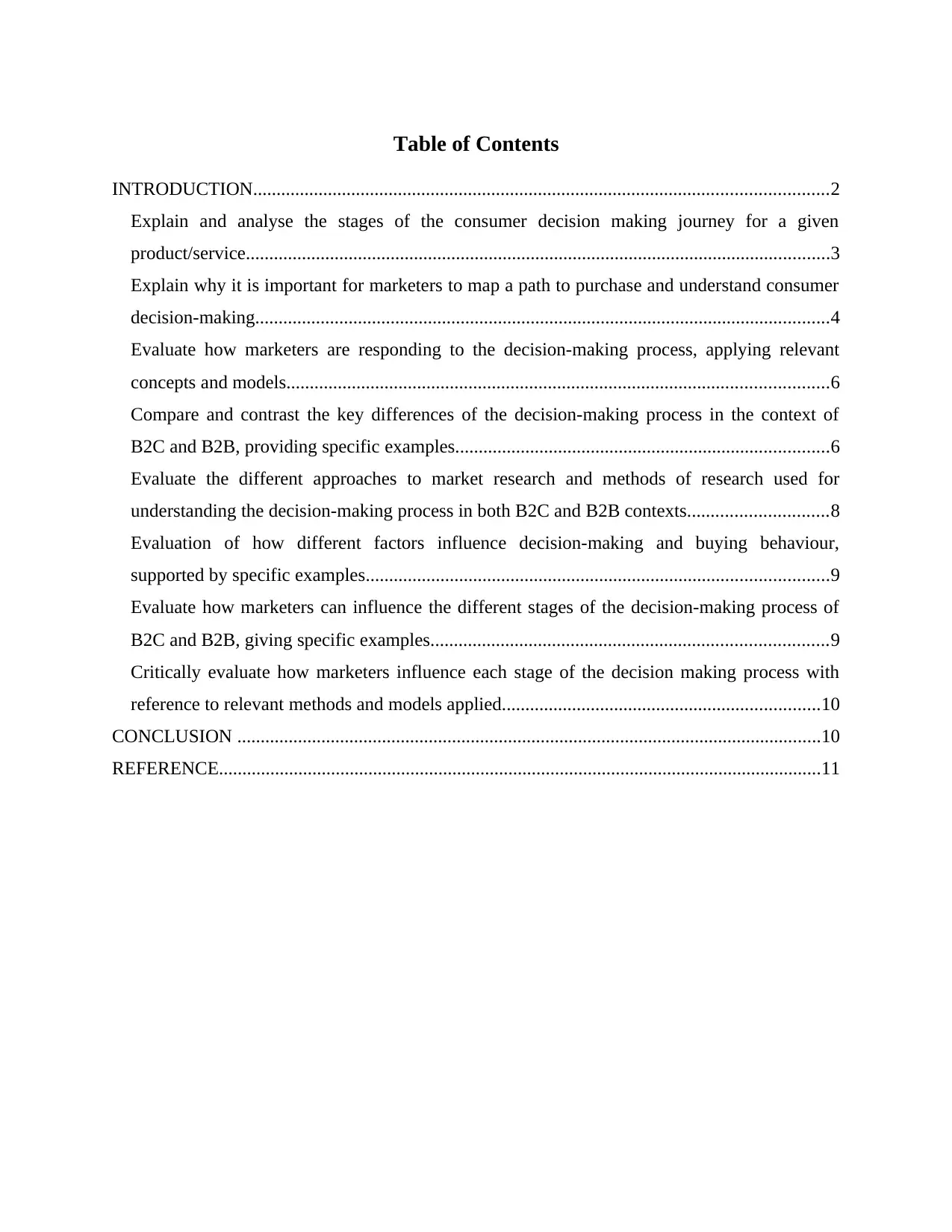
Table of Contents
INTRODUCTION...........................................................................................................................2
Explain and analyse the stages of the consumer decision making journey for a given
product/service.............................................................................................................................3
Explain why it is important for marketers to map a path to purchase and understand consumer
decision-making...........................................................................................................................4
Evaluate how marketers are responding to the decision-making process, applying relevant
concepts and models....................................................................................................................6
Compare and contrast the key differences of the decision-making process in the context of
B2C and B2B, providing specific examples................................................................................6
Evaluate the different approaches to market research and methods of research used for
understanding the decision-making process in both B2C and B2B contexts..............................8
Evaluation of how different factors influence decision-making and buying behaviour,
supported by specific examples...................................................................................................9
Evaluate how marketers can influence the different stages of the decision-making process of
B2C and B2B, giving specific examples.....................................................................................9
Critically evaluate how marketers influence each stage of the decision making process with
reference to relevant methods and models applied....................................................................10
CONCLUSION .............................................................................................................................10
REFERENCE.................................................................................................................................11
INTRODUCTION...........................................................................................................................2
Explain and analyse the stages of the consumer decision making journey for a given
product/service.............................................................................................................................3
Explain why it is important for marketers to map a path to purchase and understand consumer
decision-making...........................................................................................................................4
Evaluate how marketers are responding to the decision-making process, applying relevant
concepts and models....................................................................................................................6
Compare and contrast the key differences of the decision-making process in the context of
B2C and B2B, providing specific examples................................................................................6
Evaluate the different approaches to market research and methods of research used for
understanding the decision-making process in both B2C and B2B contexts..............................8
Evaluation of how different factors influence decision-making and buying behaviour,
supported by specific examples...................................................................................................9
Evaluate how marketers can influence the different stages of the decision-making process of
B2C and B2B, giving specific examples.....................................................................................9
Critically evaluate how marketers influence each stage of the decision making process with
reference to relevant methods and models applied....................................................................10
CONCLUSION .............................................................................................................................10
REFERENCE.................................................................................................................................11
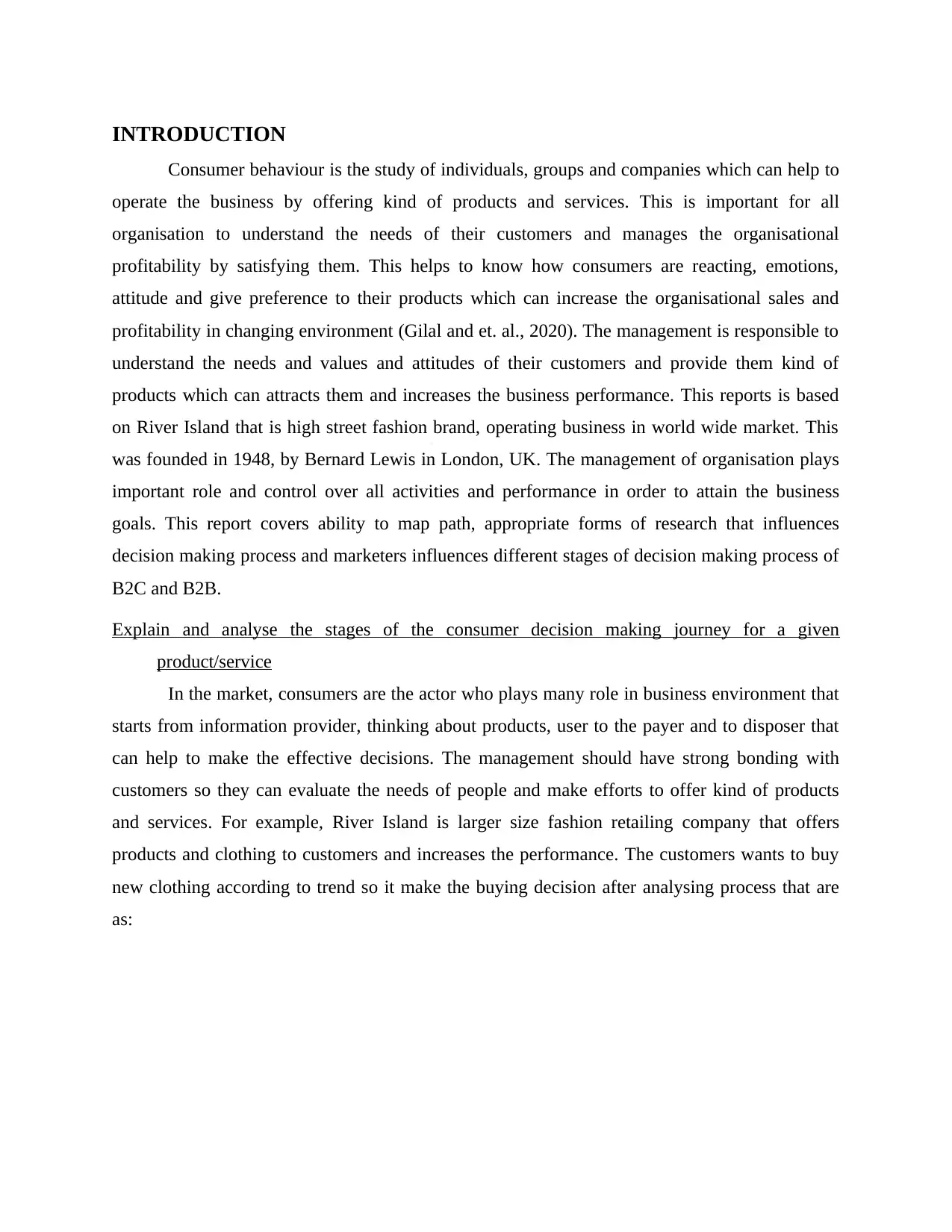
INTRODUCTION
Consumer behaviour is the study of individuals, groups and companies which can help to
operate the business by offering kind of products and services. This is important for all
organisation to understand the needs of their customers and manages the organisational
profitability by satisfying them. This helps to know how consumers are reacting, emotions,
attitude and give preference to their products which can increase the organisational sales and
profitability in changing environment (Gilal and et. al., 2020). The management is responsible to
understand the needs and values and attitudes of their customers and provide them kind of
products which can attracts them and increases the business performance. This reports is based
on River Island that is high street fashion brand, operating business in world wide market. This
was founded in 1948, by Bernard Lewis in London, UK. The management of organisation plays
important role and control over all activities and performance in order to attain the business
goals. This report covers ability to map path, appropriate forms of research that influences
decision making process and marketers influences different stages of decision making process of
B2C and B2B.
Explain and analyse the stages of the consumer decision making journey for a given
product/service
In the market, consumers are the actor who plays many role in business environment that
starts from information provider, thinking about products, user to the payer and to disposer that
can help to make the effective decisions. The management should have strong bonding with
customers so they can evaluate the needs of people and make efforts to offer kind of products
and services. For example, River Island is larger size fashion retailing company that offers
products and clothing to customers and increases the performance. The customers wants to buy
new clothing according to trend so it make the buying decision after analysing process that are
as:
Consumer behaviour is the study of individuals, groups and companies which can help to
operate the business by offering kind of products and services. This is important for all
organisation to understand the needs of their customers and manages the organisational
profitability by satisfying them. This helps to know how consumers are reacting, emotions,
attitude and give preference to their products which can increase the organisational sales and
profitability in changing environment (Gilal and et. al., 2020). The management is responsible to
understand the needs and values and attitudes of their customers and provide them kind of
products which can attracts them and increases the business performance. This reports is based
on River Island that is high street fashion brand, operating business in world wide market. This
was founded in 1948, by Bernard Lewis in London, UK. The management of organisation plays
important role and control over all activities and performance in order to attain the business
goals. This report covers ability to map path, appropriate forms of research that influences
decision making process and marketers influences different stages of decision making process of
B2C and B2B.
Explain and analyse the stages of the consumer decision making journey for a given
product/service
In the market, consumers are the actor who plays many role in business environment that
starts from information provider, thinking about products, user to the payer and to disposer that
can help to make the effective decisions. The management should have strong bonding with
customers so they can evaluate the needs of people and make efforts to offer kind of products
and services. For example, River Island is larger size fashion retailing company that offers
products and clothing to customers and increases the performance. The customers wants to buy
new clothing according to trend so it make the buying decision after analysing process that are
as:
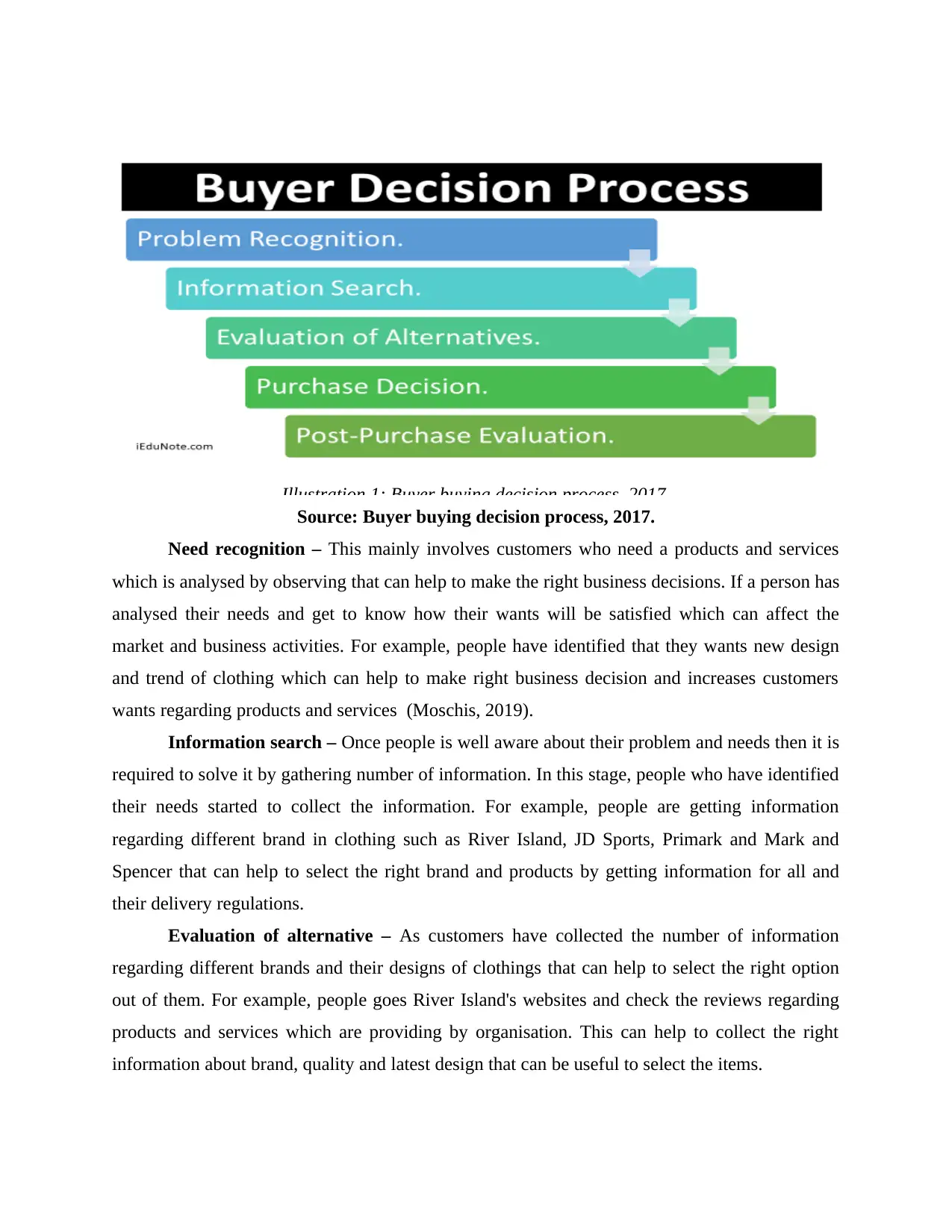
Illustration 1: Buyer buying decision process, 2017.
Source: Buyer buying decision process, 2017.
Need recognition – This mainly involves customers who need a products and services
which is analysed by observing that can help to make the right business decisions. If a person has
analysed their needs and get to know how their wants will be satisfied which can affect the
market and business activities. For example, people have identified that they wants new design
and trend of clothing which can help to make right business decision and increases customers
wants regarding products and services (Moschis, 2019).
Information search – Once people is well aware about their problem and needs then it is
required to solve it by gathering number of information. In this stage, people who have identified
their needs started to collect the information. For example, people are getting information
regarding different brand in clothing such as River Island, JD Sports, Primark and Mark and
Spencer that can help to select the right brand and products by getting information for all and
their delivery regulations.
Evaluation of alternative – As customers have collected the number of information
regarding different brands and their designs of clothings that can help to select the right option
out of them. For example, people goes River Island's websites and check the reviews regarding
products and services which are providing by organisation. This can help to collect the right
information about brand, quality and latest design that can be useful to select the items.
Source: Buyer buying decision process, 2017.
Need recognition – This mainly involves customers who need a products and services
which is analysed by observing that can help to make the right business decisions. If a person has
analysed their needs and get to know how their wants will be satisfied which can affect the
market and business activities. For example, people have identified that they wants new design
and trend of clothing which can help to make right business decision and increases customers
wants regarding products and services (Moschis, 2019).
Information search – Once people is well aware about their problem and needs then it is
required to solve it by gathering number of information. In this stage, people who have identified
their needs started to collect the information. For example, people are getting information
regarding different brand in clothing such as River Island, JD Sports, Primark and Mark and
Spencer that can help to select the right brand and products by getting information for all and
their delivery regulations.
Evaluation of alternative – As customers have collected the number of information
regarding different brands and their designs of clothings that can help to select the right option
out of them. For example, people goes River Island's websites and check the reviews regarding
products and services which are providing by organisation. This can help to collect the right
information about brand, quality and latest design that can be useful to select the items.
Secure Best Marks with AI Grader
Need help grading? Try our AI Grader for instant feedback on your assignments.
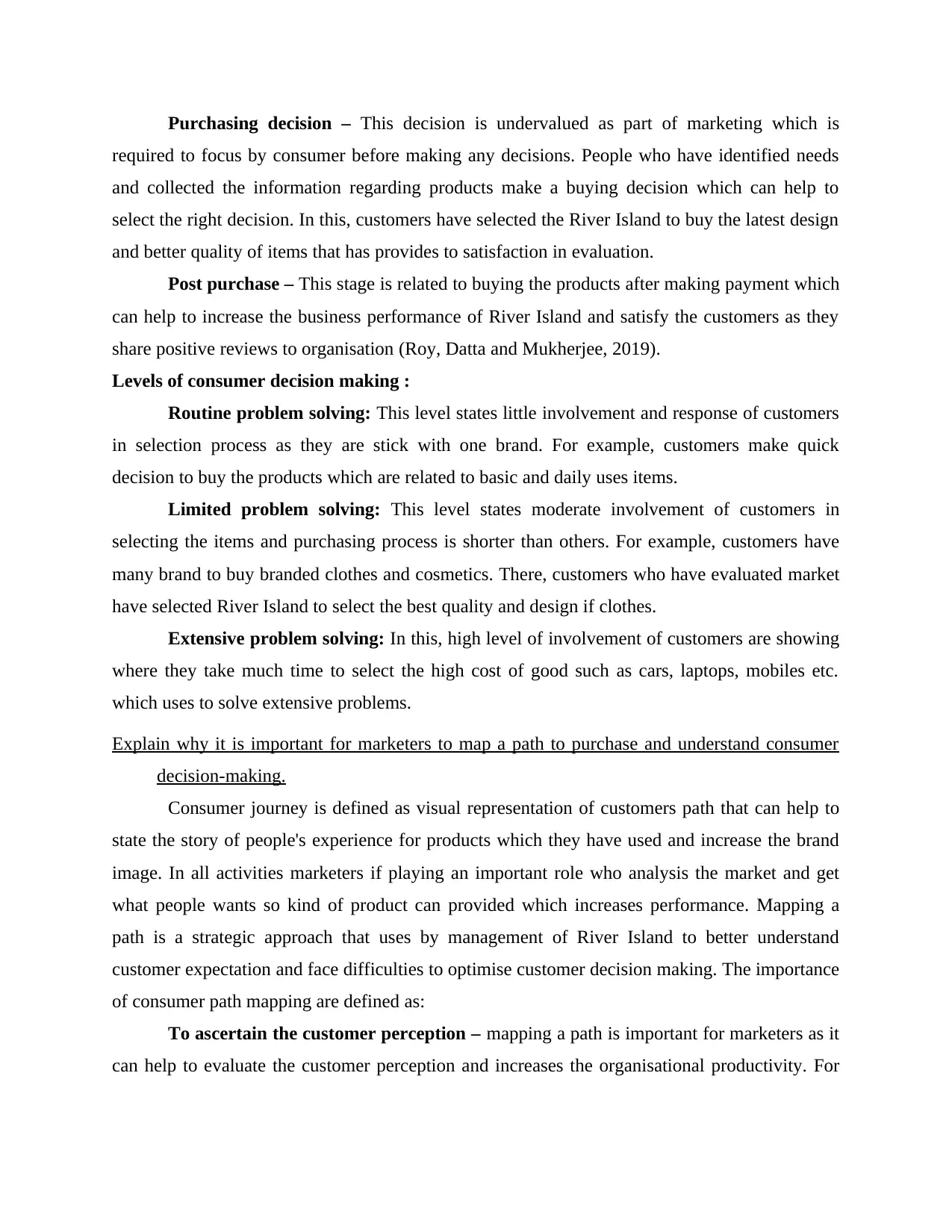
Purchasing decision – This decision is undervalued as part of marketing which is
required to focus by consumer before making any decisions. People who have identified needs
and collected the information regarding products make a buying decision which can help to
select the right decision. In this, customers have selected the River Island to buy the latest design
and better quality of items that has provides to satisfaction in evaluation.
Post purchase – This stage is related to buying the products after making payment which
can help to increase the business performance of River Island and satisfy the customers as they
share positive reviews to organisation (Roy, Datta and Mukherjee, 2019).
Levels of consumer decision making :
Routine problem solving: This level states little involvement and response of customers
in selection process as they are stick with one brand. For example, customers make quick
decision to buy the products which are related to basic and daily uses items.
Limited problem solving: This level states moderate involvement of customers in
selecting the items and purchasing process is shorter than others. For example, customers have
many brand to buy branded clothes and cosmetics. There, customers who have evaluated market
have selected River Island to select the best quality and design if clothes.
Extensive problem solving: In this, high level of involvement of customers are showing
where they take much time to select the high cost of good such as cars, laptops, mobiles etc.
which uses to solve extensive problems.
Explain why it is important for marketers to map a path to purchase and understand consumer
decision-making.
Consumer journey is defined as visual representation of customers path that can help to
state the story of people's experience for products which they have used and increase the brand
image. In all activities marketers if playing an important role who analysis the market and get
what people wants so kind of product can provided which increases performance. Mapping a
path is a strategic approach that uses by management of River Island to better understand
customer expectation and face difficulties to optimise customer decision making. The importance
of consumer path mapping are defined as:
To ascertain the customer perception – mapping a path is important for marketers as it
can help to evaluate the customer perception and increases the organisational productivity. For
required to focus by consumer before making any decisions. People who have identified needs
and collected the information regarding products make a buying decision which can help to
select the right decision. In this, customers have selected the River Island to buy the latest design
and better quality of items that has provides to satisfaction in evaluation.
Post purchase – This stage is related to buying the products after making payment which
can help to increase the business performance of River Island and satisfy the customers as they
share positive reviews to organisation (Roy, Datta and Mukherjee, 2019).
Levels of consumer decision making :
Routine problem solving: This level states little involvement and response of customers
in selection process as they are stick with one brand. For example, customers make quick
decision to buy the products which are related to basic and daily uses items.
Limited problem solving: This level states moderate involvement of customers in
selecting the items and purchasing process is shorter than others. For example, customers have
many brand to buy branded clothes and cosmetics. There, customers who have evaluated market
have selected River Island to select the best quality and design if clothes.
Extensive problem solving: In this, high level of involvement of customers are showing
where they take much time to select the high cost of good such as cars, laptops, mobiles etc.
which uses to solve extensive problems.
Explain why it is important for marketers to map a path to purchase and understand consumer
decision-making.
Consumer journey is defined as visual representation of customers path that can help to
state the story of people's experience for products which they have used and increase the brand
image. In all activities marketers if playing an important role who analysis the market and get
what people wants so kind of product can provided which increases performance. Mapping a
path is a strategic approach that uses by management of River Island to better understand
customer expectation and face difficulties to optimise customer decision making. The importance
of consumer path mapping are defined as:
To ascertain the customer perception – mapping a path is important for marketers as it
can help to evaluate the customer perception and increases the organisational productivity. For
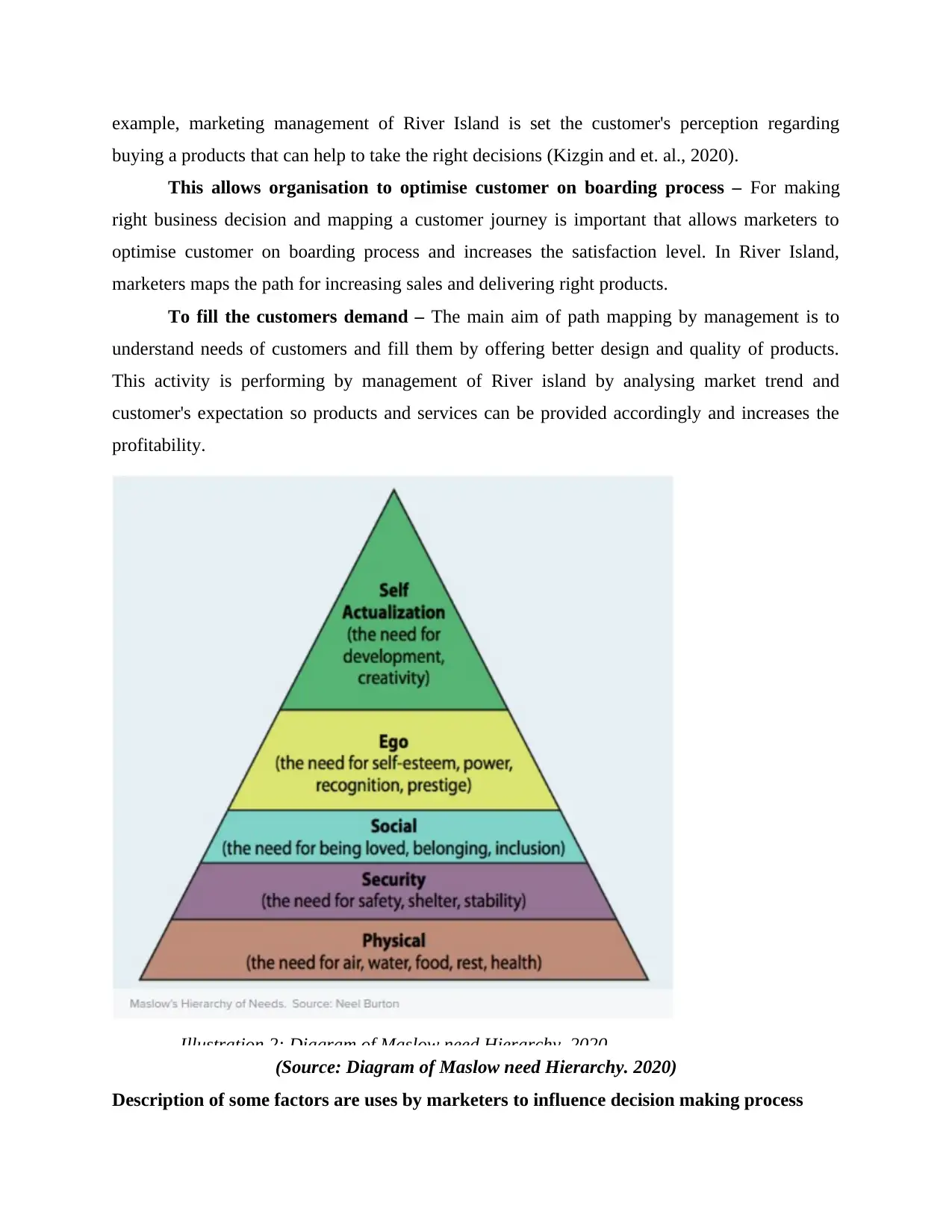
example, marketing management of River Island is set the customer's perception regarding
buying a products that can help to take the right decisions (Kizgin and et. al., 2020).
This allows organisation to optimise customer on boarding process – For making
right business decision and mapping a customer journey is important that allows marketers to
optimise customer on boarding process and increases the satisfaction level. In River Island,
marketers maps the path for increasing sales and delivering right products.
To fill the customers demand – The main aim of path mapping by management is to
understand needs of customers and fill them by offering better design and quality of products.
This activity is performing by management of River island by analysing market trend and
customer's expectation so products and services can be provided accordingly and increases the
profitability.
Illustration 2: Diagram of Maslow need Hierarchy. 2020
(Source: Diagram of Maslow need Hierarchy. 2020)
Description of some factors are uses by marketers to influence decision making process
buying a products that can help to take the right decisions (Kizgin and et. al., 2020).
This allows organisation to optimise customer on boarding process – For making
right business decision and mapping a customer journey is important that allows marketers to
optimise customer on boarding process and increases the satisfaction level. In River Island,
marketers maps the path for increasing sales and delivering right products.
To fill the customers demand – The main aim of path mapping by management is to
understand needs of customers and fill them by offering better design and quality of products.
This activity is performing by management of River island by analysing market trend and
customer's expectation so products and services can be provided accordingly and increases the
profitability.
Illustration 2: Diagram of Maslow need Hierarchy. 2020
(Source: Diagram of Maslow need Hierarchy. 2020)
Description of some factors are uses by marketers to influence decision making process
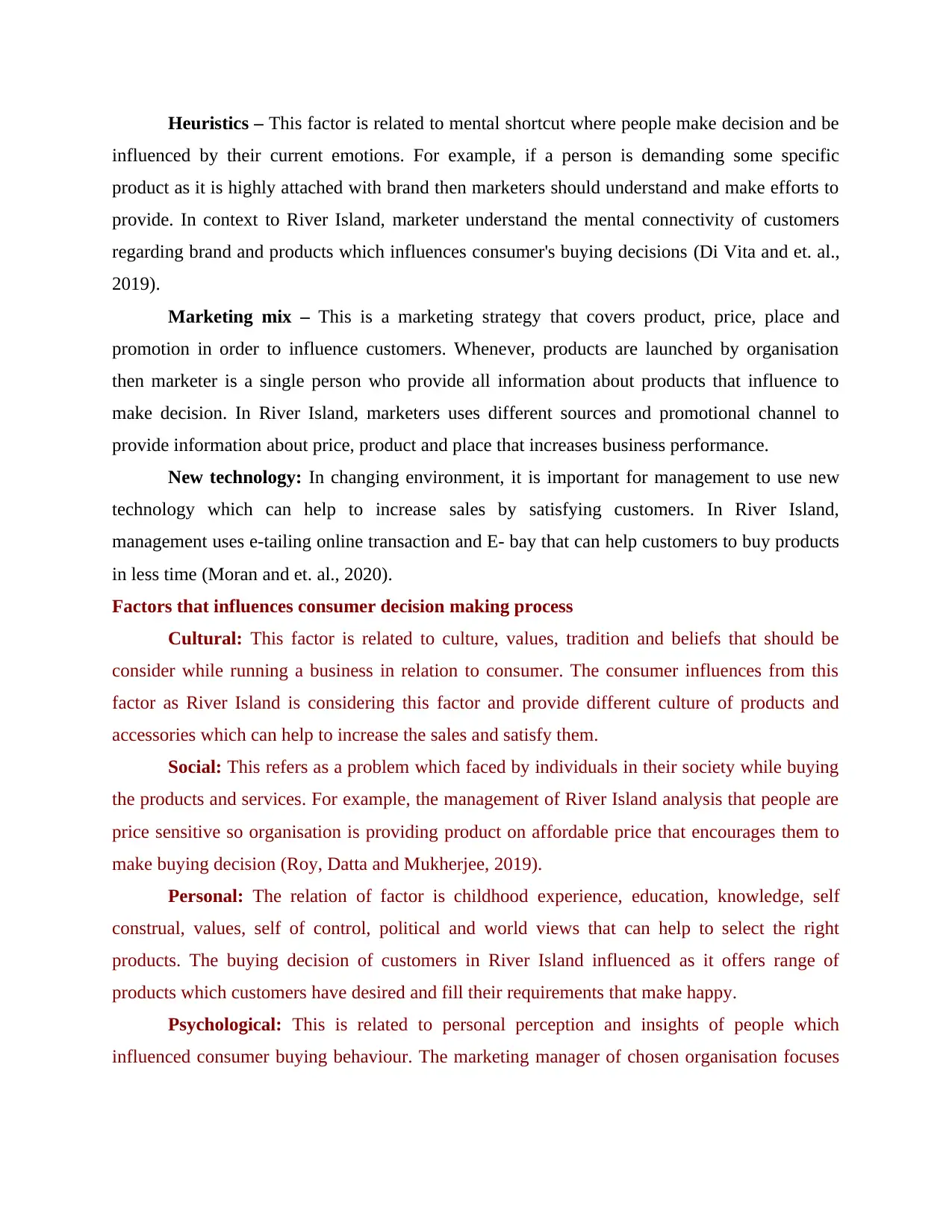
Heuristics – This factor is related to mental shortcut where people make decision and be
influenced by their current emotions. For example, if a person is demanding some specific
product as it is highly attached with brand then marketers should understand and make efforts to
provide. In context to River Island, marketer understand the mental connectivity of customers
regarding brand and products which influences consumer's buying decisions (Di Vita and et. al.,
2019).
Marketing mix – This is a marketing strategy that covers product, price, place and
promotion in order to influence customers. Whenever, products are launched by organisation
then marketer is a single person who provide all information about products that influence to
make decision. In River Island, marketers uses different sources and promotional channel to
provide information about price, product and place that increases business performance.
New technology: In changing environment, it is important for management to use new
technology which can help to increase sales by satisfying customers. In River Island,
management uses e-tailing online transaction and E- bay that can help customers to buy products
in less time (Moran and et. al., 2020).
Factors that influences consumer decision making process
Cultural: This factor is related to culture, values, tradition and beliefs that should be
consider while running a business in relation to consumer. The consumer influences from this
factor as River Island is considering this factor and provide different culture of products and
accessories which can help to increase the sales and satisfy them.
Social: This refers as a problem which faced by individuals in their society while buying
the products and services. For example, the management of River Island analysis that people are
price sensitive so organisation is providing product on affordable price that encourages them to
make buying decision (Roy, Datta and Mukherjee, 2019).
Personal: The relation of factor is childhood experience, education, knowledge, self
construal, values, self of control, political and world views that can help to select the right
products. The buying decision of customers in River Island influenced as it offers range of
products which customers have desired and fill their requirements that make happy.
Psychological: This is related to personal perception and insights of people which
influenced consumer buying behaviour. The marketing manager of chosen organisation focuses
influenced by their current emotions. For example, if a person is demanding some specific
product as it is highly attached with brand then marketers should understand and make efforts to
provide. In context to River Island, marketer understand the mental connectivity of customers
regarding brand and products which influences consumer's buying decisions (Di Vita and et. al.,
2019).
Marketing mix – This is a marketing strategy that covers product, price, place and
promotion in order to influence customers. Whenever, products are launched by organisation
then marketer is a single person who provide all information about products that influence to
make decision. In River Island, marketers uses different sources and promotional channel to
provide information about price, product and place that increases business performance.
New technology: In changing environment, it is important for management to use new
technology which can help to increase sales by satisfying customers. In River Island,
management uses e-tailing online transaction and E- bay that can help customers to buy products
in less time (Moran and et. al., 2020).
Factors that influences consumer decision making process
Cultural: This factor is related to culture, values, tradition and beliefs that should be
consider while running a business in relation to consumer. The consumer influences from this
factor as River Island is considering this factor and provide different culture of products and
accessories which can help to increase the sales and satisfy them.
Social: This refers as a problem which faced by individuals in their society while buying
the products and services. For example, the management of River Island analysis that people are
price sensitive so organisation is providing product on affordable price that encourages them to
make buying decision (Roy, Datta and Mukherjee, 2019).
Personal: The relation of factor is childhood experience, education, knowledge, self
construal, values, self of control, political and world views that can help to select the right
products. The buying decision of customers in River Island influenced as it offers range of
products which customers have desired and fill their requirements that make happy.
Psychological: This is related to personal perception and insights of people which
influenced consumer buying behaviour. The marketing manager of chosen organisation focuses
Paraphrase This Document
Need a fresh take? Get an instant paraphrase of this document with our AI Paraphraser
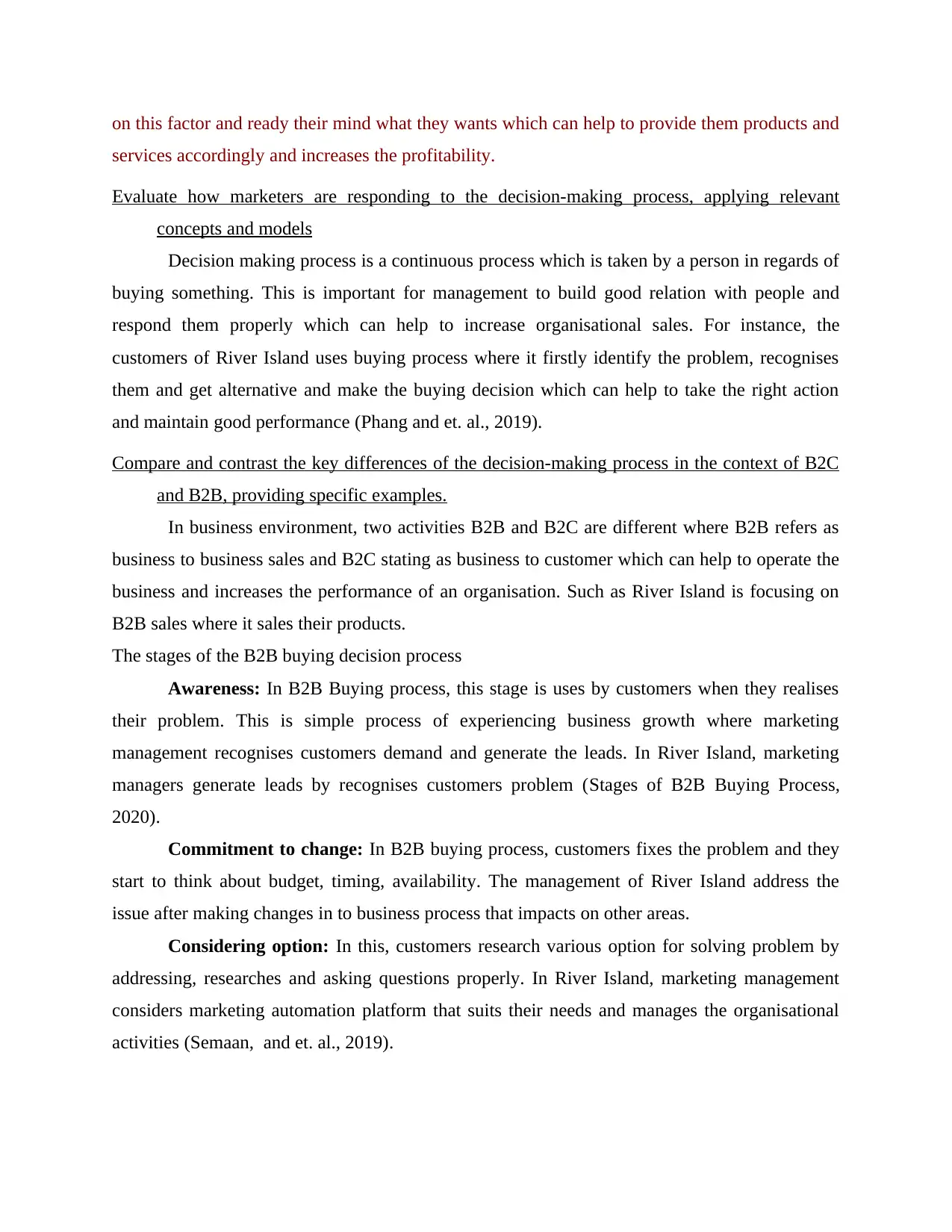
on this factor and ready their mind what they wants which can help to provide them products and
services accordingly and increases the profitability.
Evaluate how marketers are responding to the decision-making process, applying relevant
concepts and models
Decision making process is a continuous process which is taken by a person in regards of
buying something. This is important for management to build good relation with people and
respond them properly which can help to increase organisational sales. For instance, the
customers of River Island uses buying process where it firstly identify the problem, recognises
them and get alternative and make the buying decision which can help to take the right action
and maintain good performance (Phang and et. al., 2019).
Compare and contrast the key differences of the decision-making process in the context of B2C
and B2B, providing specific examples.
In business environment, two activities B2B and B2C are different where B2B refers as
business to business sales and B2C stating as business to customer which can help to operate the
business and increases the performance of an organisation. Such as River Island is focusing on
B2B sales where it sales their products.
The stages of the B2B buying decision process
Awareness: In B2B Buying process, this stage is uses by customers when they realises
their problem. This is simple process of experiencing business growth where marketing
management recognises customers demand and generate the leads. In River Island, marketing
managers generate leads by recognises customers problem (Stages of B2B Buying Process,
2020).
Commitment to change: In B2B buying process, customers fixes the problem and they
start to think about budget, timing, availability. The management of River Island address the
issue after making changes in to business process that impacts on other areas.
Considering option: In this, customers research various option for solving problem by
addressing, researches and asking questions properly. In River Island, marketing management
considers marketing automation platform that suits their needs and manages the organisational
activities (Semaan, and et. al., 2019).
services accordingly and increases the profitability.
Evaluate how marketers are responding to the decision-making process, applying relevant
concepts and models
Decision making process is a continuous process which is taken by a person in regards of
buying something. This is important for management to build good relation with people and
respond them properly which can help to increase organisational sales. For instance, the
customers of River Island uses buying process where it firstly identify the problem, recognises
them and get alternative and make the buying decision which can help to take the right action
and maintain good performance (Phang and et. al., 2019).
Compare and contrast the key differences of the decision-making process in the context of B2C
and B2B, providing specific examples.
In business environment, two activities B2B and B2C are different where B2B refers as
business to business sales and B2C stating as business to customer which can help to operate the
business and increases the performance of an organisation. Such as River Island is focusing on
B2B sales where it sales their products.
The stages of the B2B buying decision process
Awareness: In B2B Buying process, this stage is uses by customers when they realises
their problem. This is simple process of experiencing business growth where marketing
management recognises customers demand and generate the leads. In River Island, marketing
managers generate leads by recognises customers problem (Stages of B2B Buying Process,
2020).
Commitment to change: In B2B buying process, customers fixes the problem and they
start to think about budget, timing, availability. The management of River Island address the
issue after making changes in to business process that impacts on other areas.
Considering option: In this, customers research various option for solving problem by
addressing, researches and asking questions properly. In River Island, marketing management
considers marketing automation platform that suits their needs and manages the organisational
activities (Semaan, and et. al., 2019).
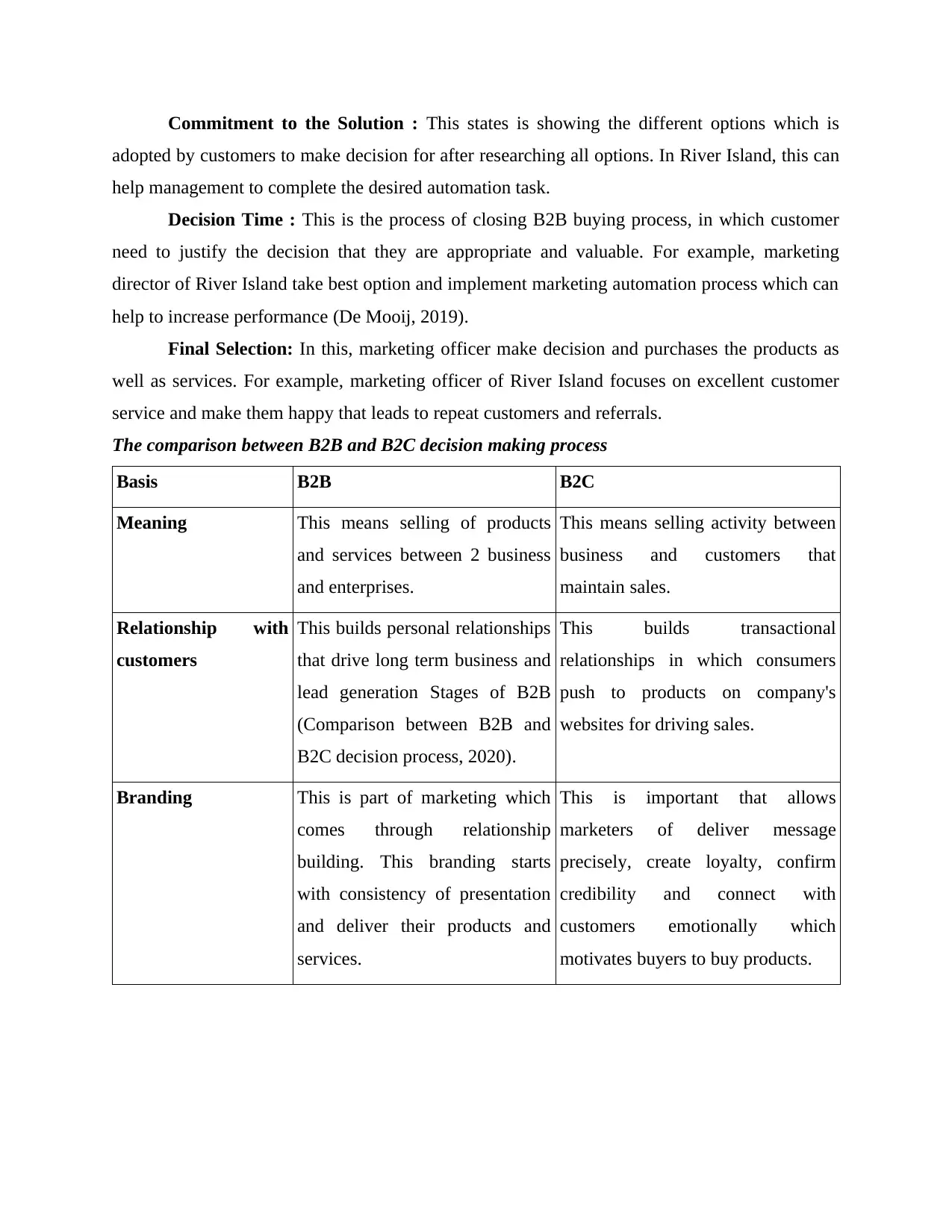
Commitment to the Solution : This states is showing the different options which is
adopted by customers to make decision for after researching all options. In River Island, this can
help management to complete the desired automation task.
Decision Time : This is the process of closing B2B buying process, in which customer
need to justify the decision that they are appropriate and valuable. For example, marketing
director of River Island take best option and implement marketing automation process which can
help to increase performance (De Mooij, 2019).
Final Selection: In this, marketing officer make decision and purchases the products as
well as services. For example, marketing officer of River Island focuses on excellent customer
service and make them happy that leads to repeat customers and referrals.
The comparison between B2B and B2C decision making process
Basis B2B B2C
Meaning This means selling of products
and services between 2 business
and enterprises.
This means selling activity between
business and customers that
maintain sales.
Relationship with
customers
This builds personal relationships
that drive long term business and
lead generation Stages of B2B
(Comparison between B2B and
B2C decision process, 2020).
This builds transactional
relationships in which consumers
push to products on company's
websites for driving sales.
Branding This is part of marketing which
comes through relationship
building. This branding starts
with consistency of presentation
and deliver their products and
services.
This is important that allows
marketers of deliver message
precisely, create loyalty, confirm
credibility and connect with
customers emotionally which
motivates buyers to buy products.
adopted by customers to make decision for after researching all options. In River Island, this can
help management to complete the desired automation task.
Decision Time : This is the process of closing B2B buying process, in which customer
need to justify the decision that they are appropriate and valuable. For example, marketing
director of River Island take best option and implement marketing automation process which can
help to increase performance (De Mooij, 2019).
Final Selection: In this, marketing officer make decision and purchases the products as
well as services. For example, marketing officer of River Island focuses on excellent customer
service and make them happy that leads to repeat customers and referrals.
The comparison between B2B and B2C decision making process
Basis B2B B2C
Meaning This means selling of products
and services between 2 business
and enterprises.
This means selling activity between
business and customers that
maintain sales.
Relationship with
customers
This builds personal relationships
that drive long term business and
lead generation Stages of B2B
(Comparison between B2B and
B2C decision process, 2020).
This builds transactional
relationships in which consumers
push to products on company's
websites for driving sales.
Branding This is part of marketing which
comes through relationship
building. This branding starts
with consistency of presentation
and deliver their products and
services.
This is important that allows
marketers of deliver message
precisely, create loyalty, confirm
credibility and connect with
customers emotionally which
motivates buyers to buy products.
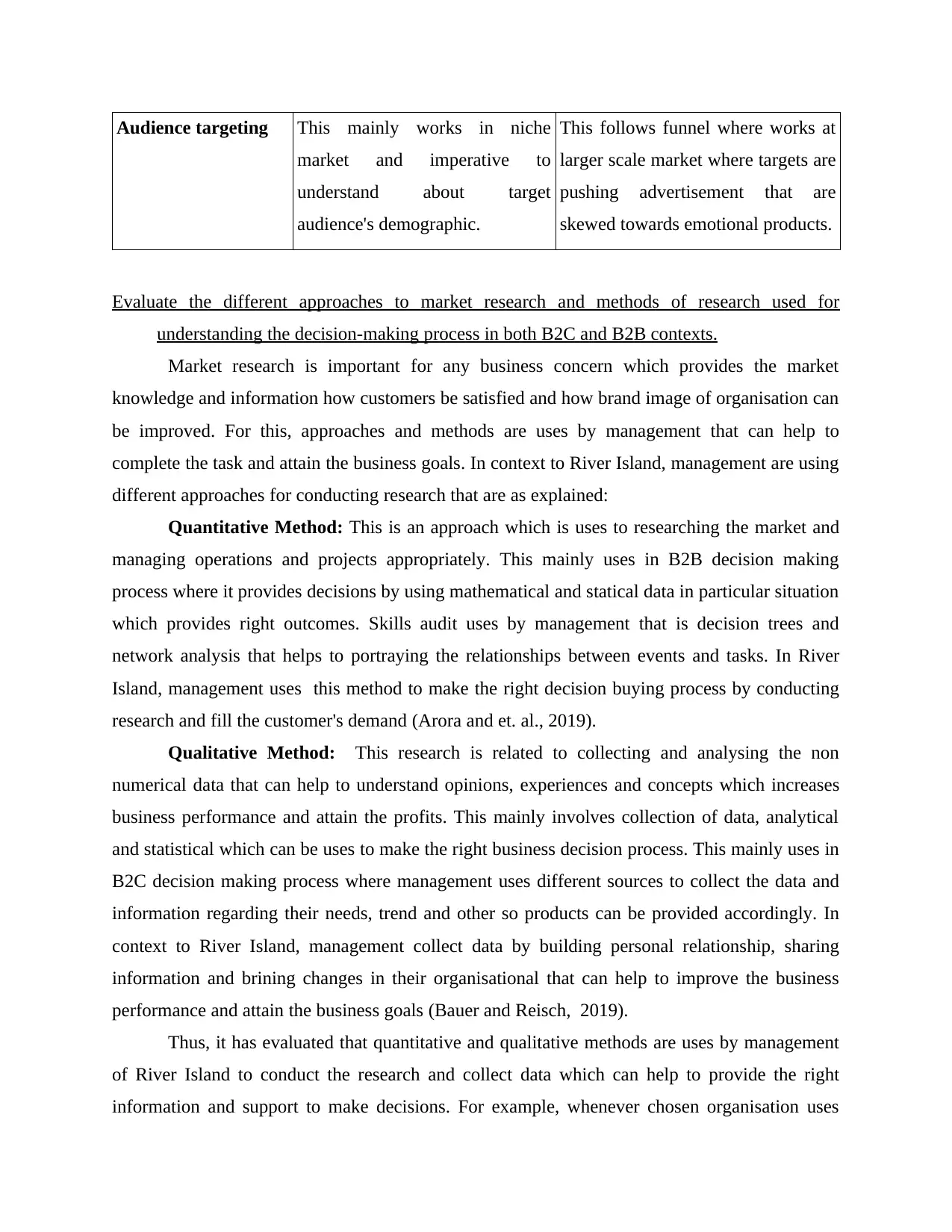
Audience targeting This mainly works in niche
market and imperative to
understand about target
audience's demographic.
This follows funnel where works at
larger scale market where targets are
pushing advertisement that are
skewed towards emotional products.
Evaluate the different approaches to market research and methods of research used for
understanding the decision-making process in both B2C and B2B contexts.
Market research is important for any business concern which provides the market
knowledge and information how customers be satisfied and how brand image of organisation can
be improved. For this, approaches and methods are uses by management that can help to
complete the task and attain the business goals. In context to River Island, management are using
different approaches for conducting research that are as explained:
Quantitative Method: This is an approach which is uses to researching the market and
managing operations and projects appropriately. This mainly uses in B2B decision making
process where it provides decisions by using mathematical and statical data in particular situation
which provides right outcomes. Skills audit uses by management that is decision trees and
network analysis that helps to portraying the relationships between events and tasks. In River
Island, management uses this method to make the right decision buying process by conducting
research and fill the customer's demand (Arora and et. al., 2019).
Qualitative Method: This research is related to collecting and analysing the non
numerical data that can help to understand opinions, experiences and concepts which increases
business performance and attain the profits. This mainly involves collection of data, analytical
and statistical which can be uses to make the right business decision process. This mainly uses in
B2C decision making process where management uses different sources to collect the data and
information regarding their needs, trend and other so products can be provided accordingly. In
context to River Island, management collect data by building personal relationship, sharing
information and brining changes in their organisational that can help to improve the business
performance and attain the business goals (Bauer and Reisch, 2019).
Thus, it has evaluated that quantitative and qualitative methods are uses by management
of River Island to conduct the research and collect data which can help to provide the right
information and support to make decisions. For example, whenever chosen organisation uses
market and imperative to
understand about target
audience's demographic.
This follows funnel where works at
larger scale market where targets are
pushing advertisement that are
skewed towards emotional products.
Evaluate the different approaches to market research and methods of research used for
understanding the decision-making process in both B2C and B2B contexts.
Market research is important for any business concern which provides the market
knowledge and information how customers be satisfied and how brand image of organisation can
be improved. For this, approaches and methods are uses by management that can help to
complete the task and attain the business goals. In context to River Island, management are using
different approaches for conducting research that are as explained:
Quantitative Method: This is an approach which is uses to researching the market and
managing operations and projects appropriately. This mainly uses in B2B decision making
process where it provides decisions by using mathematical and statical data in particular situation
which provides right outcomes. Skills audit uses by management that is decision trees and
network analysis that helps to portraying the relationships between events and tasks. In River
Island, management uses this method to make the right decision buying process by conducting
research and fill the customer's demand (Arora and et. al., 2019).
Qualitative Method: This research is related to collecting and analysing the non
numerical data that can help to understand opinions, experiences and concepts which increases
business performance and attain the profits. This mainly involves collection of data, analytical
and statistical which can be uses to make the right business decision process. This mainly uses in
B2C decision making process where management uses different sources to collect the data and
information regarding their needs, trend and other so products can be provided accordingly. In
context to River Island, management collect data by building personal relationship, sharing
information and brining changes in their organisational that can help to improve the business
performance and attain the business goals (Bauer and Reisch, 2019).
Thus, it has evaluated that quantitative and qualitative methods are uses by management
of River Island to conduct the research and collect data which can help to provide the right
information and support to make decisions. For example, whenever chosen organisation uses
Secure Best Marks with AI Grader
Need help grading? Try our AI Grader for instant feedback on your assignments.
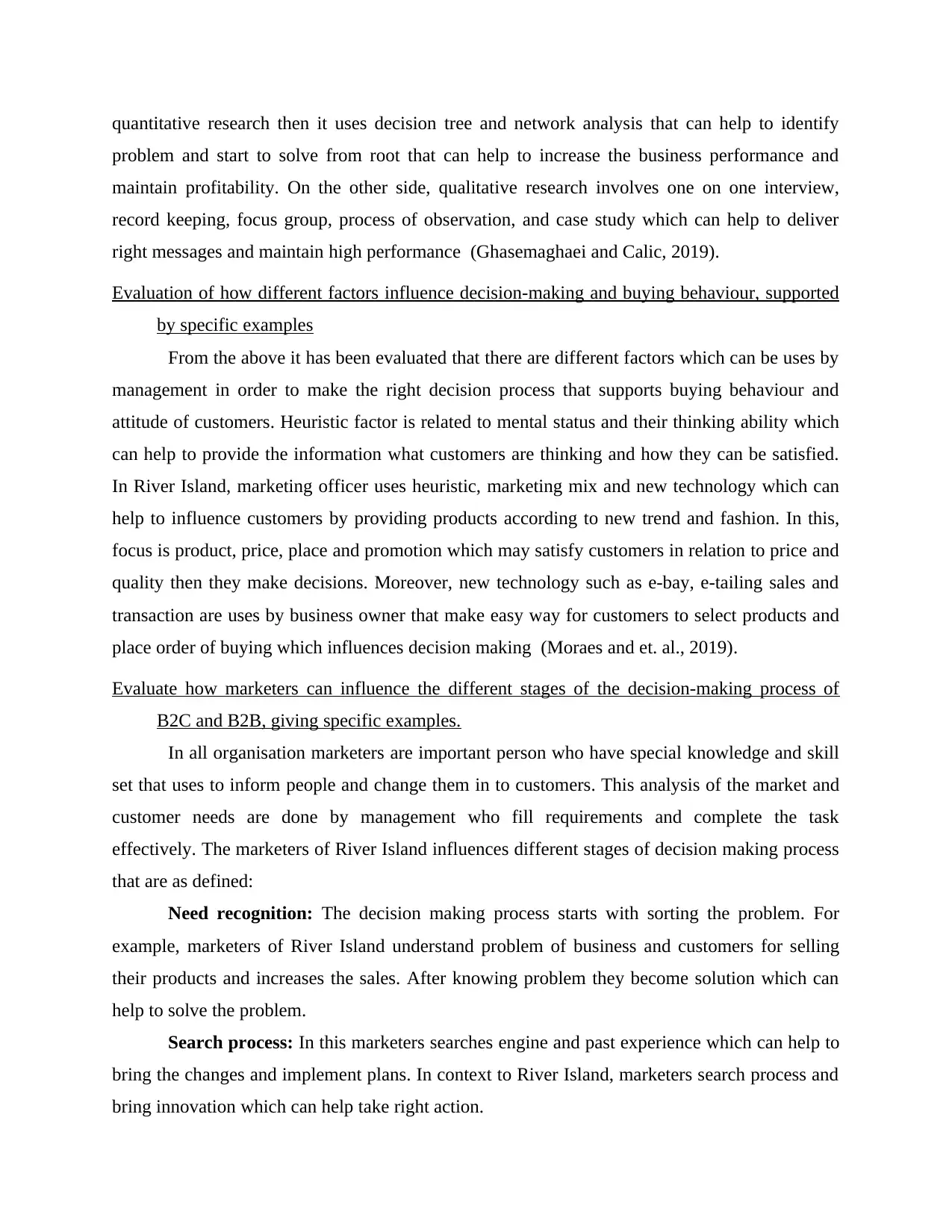
quantitative research then it uses decision tree and network analysis that can help to identify
problem and start to solve from root that can help to increase the business performance and
maintain profitability. On the other side, qualitative research involves one on one interview,
record keeping, focus group, process of observation, and case study which can help to deliver
right messages and maintain high performance (Ghasemaghaei and Calic, 2019).
Evaluation of how different factors influence decision-making and buying behaviour, supported
by specific examples
From the above it has been evaluated that there are different factors which can be uses by
management in order to make the right decision process that supports buying behaviour and
attitude of customers. Heuristic factor is related to mental status and their thinking ability which
can help to provide the information what customers are thinking and how they can be satisfied.
In River Island, marketing officer uses heuristic, marketing mix and new technology which can
help to influence customers by providing products according to new trend and fashion. In this,
focus is product, price, place and promotion which may satisfy customers in relation to price and
quality then they make decisions. Moreover, new technology such as e-bay, e-tailing sales and
transaction are uses by business owner that make easy way for customers to select products and
place order of buying which influences decision making (Moraes and et. al., 2019).
Evaluate how marketers can influence the different stages of the decision-making process of
B2C and B2B, giving specific examples.
In all organisation marketers are important person who have special knowledge and skill
set that uses to inform people and change them in to customers. This analysis of the market and
customer needs are done by management who fill requirements and complete the task
effectively. The marketers of River Island influences different stages of decision making process
that are as defined:
Need recognition: The decision making process starts with sorting the problem. For
example, marketers of River Island understand problem of business and customers for selling
their products and increases the sales. After knowing problem they become solution which can
help to solve the problem.
Search process: In this marketers searches engine and past experience which can help to
bring the changes and implement plans. In context to River Island, marketers search process and
bring innovation which can help take right action.
problem and start to solve from root that can help to increase the business performance and
maintain profitability. On the other side, qualitative research involves one on one interview,
record keeping, focus group, process of observation, and case study which can help to deliver
right messages and maintain high performance (Ghasemaghaei and Calic, 2019).
Evaluation of how different factors influence decision-making and buying behaviour, supported
by specific examples
From the above it has been evaluated that there are different factors which can be uses by
management in order to make the right decision process that supports buying behaviour and
attitude of customers. Heuristic factor is related to mental status and their thinking ability which
can help to provide the information what customers are thinking and how they can be satisfied.
In River Island, marketing officer uses heuristic, marketing mix and new technology which can
help to influence customers by providing products according to new trend and fashion. In this,
focus is product, price, place and promotion which may satisfy customers in relation to price and
quality then they make decisions. Moreover, new technology such as e-bay, e-tailing sales and
transaction are uses by business owner that make easy way for customers to select products and
place order of buying which influences decision making (Moraes and et. al., 2019).
Evaluate how marketers can influence the different stages of the decision-making process of
B2C and B2B, giving specific examples.
In all organisation marketers are important person who have special knowledge and skill
set that uses to inform people and change them in to customers. This analysis of the market and
customer needs are done by management who fill requirements and complete the task
effectively. The marketers of River Island influences different stages of decision making process
that are as defined:
Need recognition: The decision making process starts with sorting the problem. For
example, marketers of River Island understand problem of business and customers for selling
their products and increases the sales. After knowing problem they become solution which can
help to solve the problem.
Search process: In this marketers searches engine and past experience which can help to
bring the changes and implement plans. In context to River Island, marketers search process and
bring innovation which can help take right action.
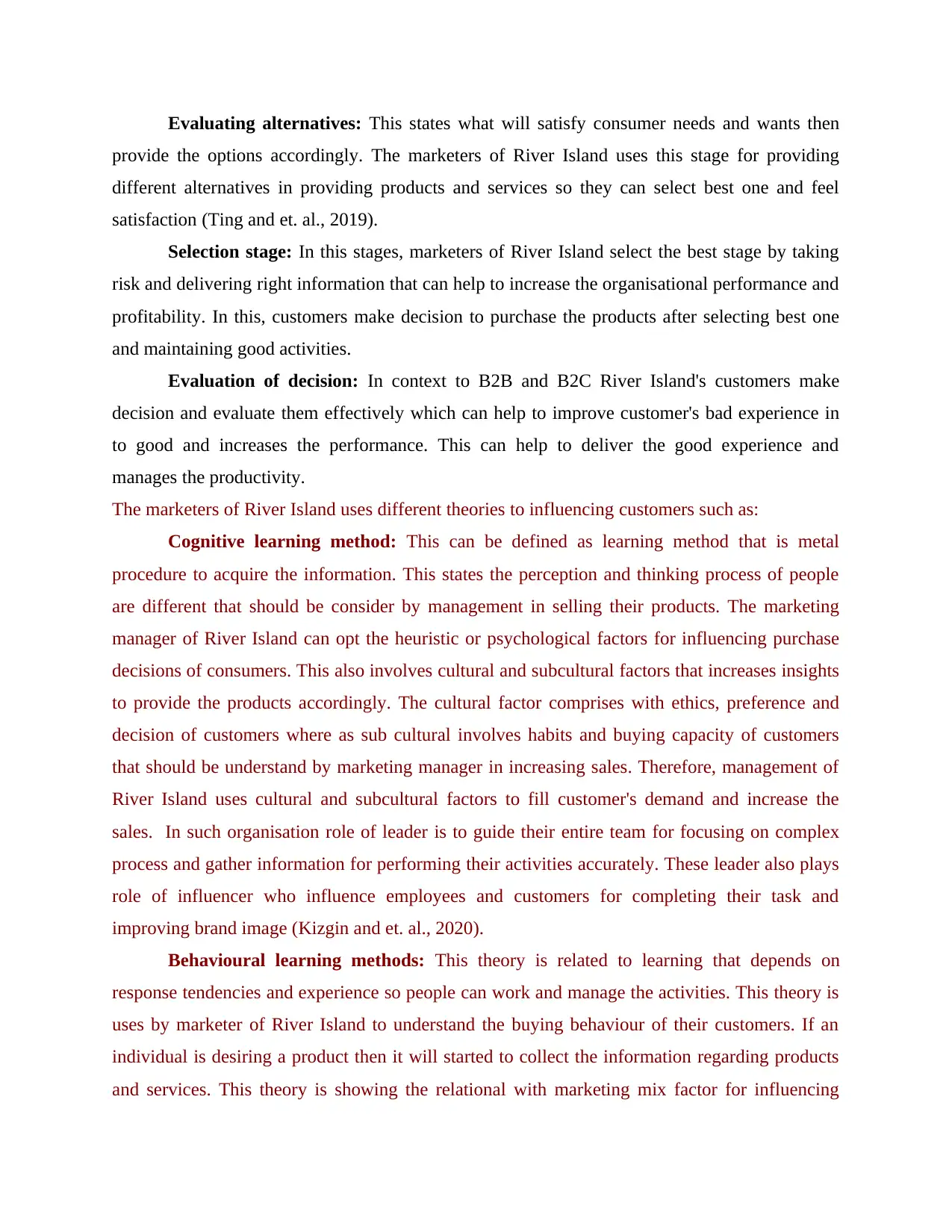
Evaluating alternatives: This states what will satisfy consumer needs and wants then
provide the options accordingly. The marketers of River Island uses this stage for providing
different alternatives in providing products and services so they can select best one and feel
satisfaction (Ting and et. al., 2019).
Selection stage: In this stages, marketers of River Island select the best stage by taking
risk and delivering right information that can help to increase the organisational performance and
profitability. In this, customers make decision to purchase the products after selecting best one
and maintaining good activities.
Evaluation of decision: In context to B2B and B2C River Island's customers make
decision and evaluate them effectively which can help to improve customer's bad experience in
to good and increases the performance. This can help to deliver the good experience and
manages the productivity.
The marketers of River Island uses different theories to influencing customers such as:
Cognitive learning method: This can be defined as learning method that is metal
procedure to acquire the information. This states the perception and thinking process of people
are different that should be consider by management in selling their products. The marketing
manager of River Island can opt the heuristic or psychological factors for influencing purchase
decisions of consumers. This also involves cultural and subcultural factors that increases insights
to provide the products accordingly. The cultural factor comprises with ethics, preference and
decision of customers where as sub cultural involves habits and buying capacity of customers
that should be understand by marketing manager in increasing sales. Therefore, management of
River Island uses cultural and subcultural factors to fill customer's demand and increase the
sales. In such organisation role of leader is to guide their entire team for focusing on complex
process and gather information for performing their activities accurately. These leader also plays
role of influencer who influence employees and customers for completing their task and
improving brand image (Kizgin and et. al., 2020).
Behavioural learning methods: This theory is related to learning that depends on
response tendencies and experience so people can work and manage the activities. This theory is
uses by marketer of River Island to understand the buying behaviour of their customers. If an
individual is desiring a product then it will started to collect the information regarding products
and services. This theory is showing the relational with marketing mix factor for influencing
provide the options accordingly. The marketers of River Island uses this stage for providing
different alternatives in providing products and services so they can select best one and feel
satisfaction (Ting and et. al., 2019).
Selection stage: In this stages, marketers of River Island select the best stage by taking
risk and delivering right information that can help to increase the organisational performance and
profitability. In this, customers make decision to purchase the products after selecting best one
and maintaining good activities.
Evaluation of decision: In context to B2B and B2C River Island's customers make
decision and evaluate them effectively which can help to improve customer's bad experience in
to good and increases the performance. This can help to deliver the good experience and
manages the productivity.
The marketers of River Island uses different theories to influencing customers such as:
Cognitive learning method: This can be defined as learning method that is metal
procedure to acquire the information. This states the perception and thinking process of people
are different that should be consider by management in selling their products. The marketing
manager of River Island can opt the heuristic or psychological factors for influencing purchase
decisions of consumers. This also involves cultural and subcultural factors that increases insights
to provide the products accordingly. The cultural factor comprises with ethics, preference and
decision of customers where as sub cultural involves habits and buying capacity of customers
that should be understand by marketing manager in increasing sales. Therefore, management of
River Island uses cultural and subcultural factors to fill customer's demand and increase the
sales. In such organisation role of leader is to guide their entire team for focusing on complex
process and gather information for performing their activities accurately. These leader also plays
role of influencer who influence employees and customers for completing their task and
improving brand image (Kizgin and et. al., 2020).
Behavioural learning methods: This theory is related to learning that depends on
response tendencies and experience so people can work and manage the activities. This theory is
uses by marketer of River Island to understand the buying behaviour of their customers. If an
individual is desiring a product then it will started to collect the information regarding products
and services. This theory is showing the relational with marketing mix factor for influencing
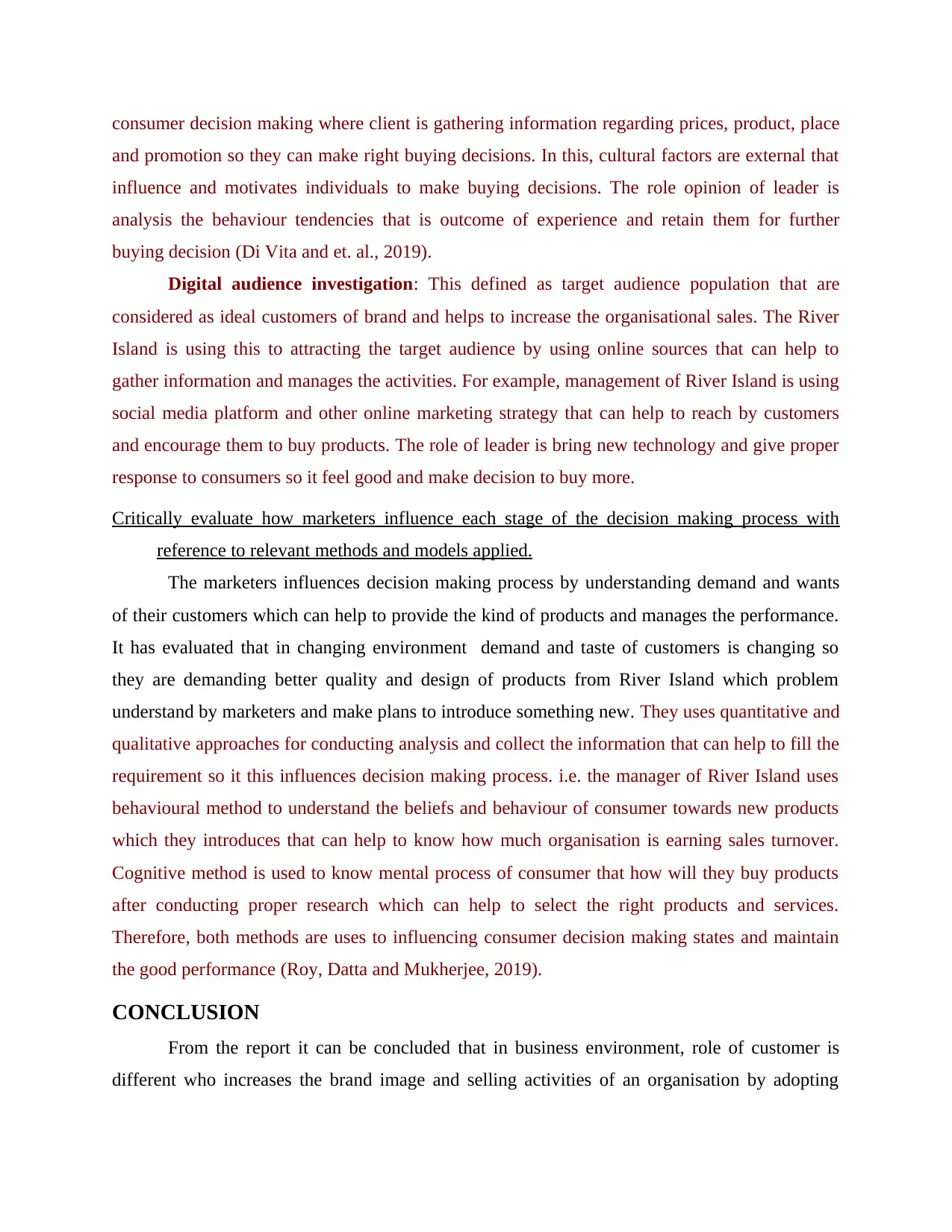
consumer decision making where client is gathering information regarding prices, product, place
and promotion so they can make right buying decisions. In this, cultural factors are external that
influence and motivates individuals to make buying decisions. The role opinion of leader is
analysis the behaviour tendencies that is outcome of experience and retain them for further
buying decision (Di Vita and et. al., 2019).
Digital audience investigation: This defined as target audience population that are
considered as ideal customers of brand and helps to increase the organisational sales. The River
Island is using this to attracting the target audience by using online sources that can help to
gather information and manages the activities. For example, management of River Island is using
social media platform and other online marketing strategy that can help to reach by customers
and encourage them to buy products. The role of leader is bring new technology and give proper
response to consumers so it feel good and make decision to buy more.
Critically evaluate how marketers influence each stage of the decision making process with
reference to relevant methods and models applied.
The marketers influences decision making process by understanding demand and wants
of their customers which can help to provide the kind of products and manages the performance.
It has evaluated that in changing environment demand and taste of customers is changing so
they are demanding better quality and design of products from River Island which problem
understand by marketers and make plans to introduce something new. They uses quantitative and
qualitative approaches for conducting analysis and collect the information that can help to fill the
requirement so it this influences decision making process. i.e. the manager of River Island uses
behavioural method to understand the beliefs and behaviour of consumer towards new products
which they introduces that can help to know how much organisation is earning sales turnover.
Cognitive method is used to know mental process of consumer that how will they buy products
after conducting proper research which can help to select the right products and services.
Therefore, both methods are uses to influencing consumer decision making states and maintain
the good performance (Roy, Datta and Mukherjee, 2019).
CONCLUSION
From the report it can be concluded that in business environment, role of customer is
different who increases the brand image and selling activities of an organisation by adopting
and promotion so they can make right buying decisions. In this, cultural factors are external that
influence and motivates individuals to make buying decisions. The role opinion of leader is
analysis the behaviour tendencies that is outcome of experience and retain them for further
buying decision (Di Vita and et. al., 2019).
Digital audience investigation: This defined as target audience population that are
considered as ideal customers of brand and helps to increase the organisational sales. The River
Island is using this to attracting the target audience by using online sources that can help to
gather information and manages the activities. For example, management of River Island is using
social media platform and other online marketing strategy that can help to reach by customers
and encourage them to buy products. The role of leader is bring new technology and give proper
response to consumers so it feel good and make decision to buy more.
Critically evaluate how marketers influence each stage of the decision making process with
reference to relevant methods and models applied.
The marketers influences decision making process by understanding demand and wants
of their customers which can help to provide the kind of products and manages the performance.
It has evaluated that in changing environment demand and taste of customers is changing so
they are demanding better quality and design of products from River Island which problem
understand by marketers and make plans to introduce something new. They uses quantitative and
qualitative approaches for conducting analysis and collect the information that can help to fill the
requirement so it this influences decision making process. i.e. the manager of River Island uses
behavioural method to understand the beliefs and behaviour of consumer towards new products
which they introduces that can help to know how much organisation is earning sales turnover.
Cognitive method is used to know mental process of consumer that how will they buy products
after conducting proper research which can help to select the right products and services.
Therefore, both methods are uses to influencing consumer decision making states and maintain
the good performance (Roy, Datta and Mukherjee, 2019).
CONCLUSION
From the report it can be concluded that in business environment, role of customer is
different who increases the brand image and selling activities of an organisation by adopting
Paraphrase This Document
Need a fresh take? Get an instant paraphrase of this document with our AI Paraphraser
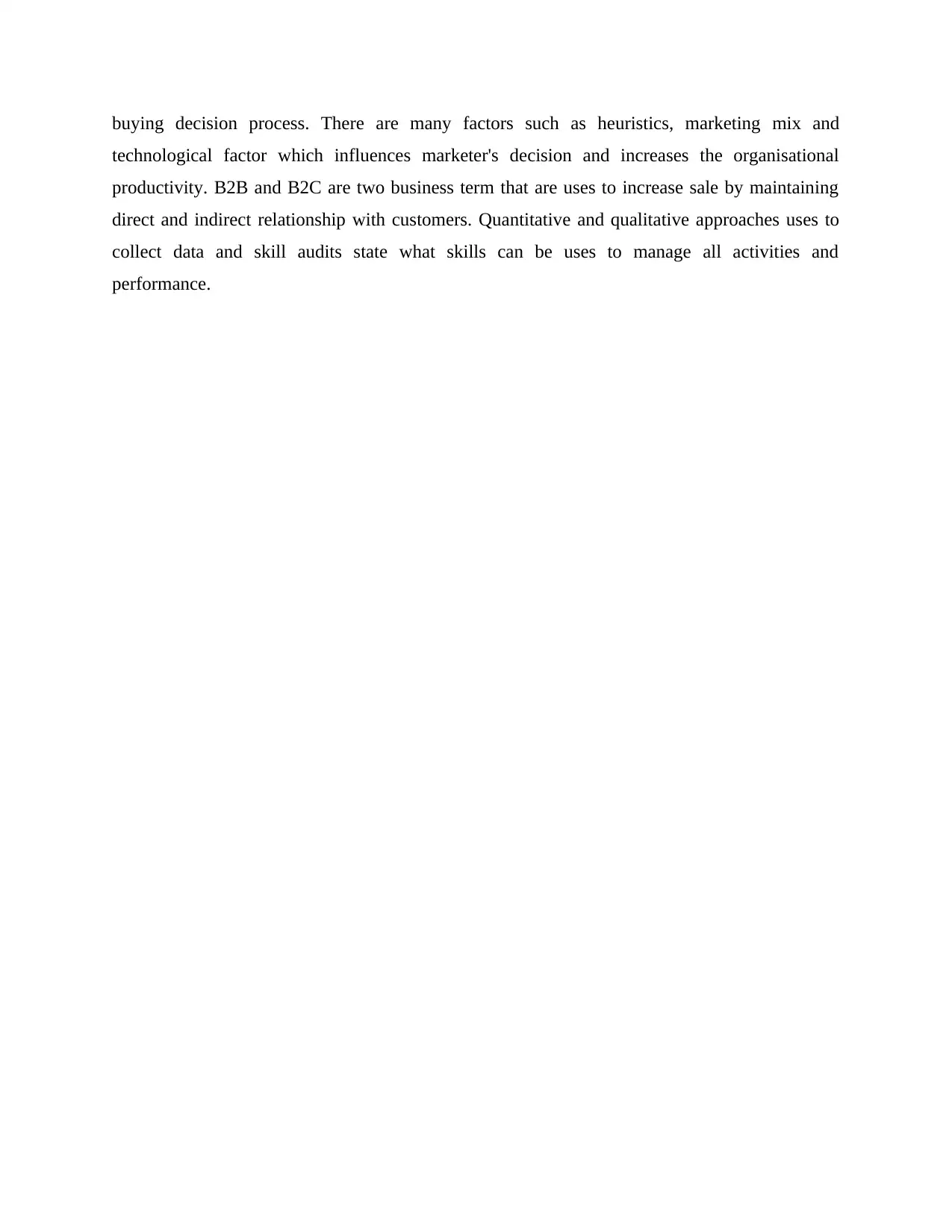
buying decision process. There are many factors such as heuristics, marketing mix and
technological factor which influences marketer's decision and increases the organisational
productivity. B2B and B2C are two business term that are uses to increase sale by maintaining
direct and indirect relationship with customers. Quantitative and qualitative approaches uses to
collect data and skill audits state what skills can be uses to manage all activities and
performance.
technological factor which influences marketer's decision and increases the organisational
productivity. B2B and B2C are two business term that are uses to increase sale by maintaining
direct and indirect relationship with customers. Quantitative and qualitative approaches uses to
collect data and skill audits state what skills can be uses to manage all activities and
performance.

REFERENCE
Books and Journal
Ting, H., and et. al., 2019. Consumer behaviour and disposition decisions: The why and how of
smartphone disposition. Journal of Retailing and Consumer Services. 51. pp.212-220.
Moraes, M., and et. al., 2019. Celebrity influences on consumer decision making: New insights
and research directions. Journal of Marketing Management. 35(13-14). pp.1159-1192.
Ghasemaghaei, M. and Calic, G., 2019. Does big data enhance firm innovation competency? The
mediating role of data-driven insights. Journal of Business Research. 104. pp.69-84.
Bauer, J. M. and Reisch, L. A., 2019. Behavioural insights and (un) healthy dietary choices: A
review of current evidence. Journal of Consumer Policy. 42(1). pp.3-45.\
Arora, A., and et. al., 2019. Measuring social media influencer index-insights from Facebook,
Twitter and Instagram. Journal of Retailing and Consumer Services. 49. pp.86-101.
De Mooij, M., 2019. Consumer behavior and culture: Consequences for global marketing and
advertising. SAGE Publications Limited.
Semaan, R. W., and et. al., 2019. The influence of gender roles in the drivers of luxury
consumption for women: Insights from the gulf region. Journal of Retailing and
Consumer Services. 51. pp.165-175.
Phang, D. C., Wand et. al., 2019. How to derive causal insights for digital commerce in China?
A research commentary on computational social science methods. Electronic Commerce
Research and Applications. 35. p.100837.
Moran, D., and et. al., 2020. Quantifying the potential for consumer-oriented policy to reduce
European and foreign carbon emissions. Climate Policy. 20(sup1). pp.S28-S38.
Di Vita, G., and et. al., 2019. Picking out a wine: Consumer motivation behind different quality
wines choice. Wine economics and policy. 8(1). pp.16-27.
Kizgin, H., and et. al., 2020. The impact of social media on consumer acculturation: Current
challenges, opportunities, and an agenda for research and practice. International Journal
of Information Management. 51. p.102026.
Roy, G., Datta, B. and Mukherjee, S., 2019. Role of electronic word-of-mouth content and
valence in influencing online purchase behavior. Journal of Marketing
Communications, 25(6), pp.661-684.
Moschis, G. P., 2019. Consumer Behavior over the Life Course Research Frontiers and New
Directions. Springer Nature.
Gilal, N. G., and et. al., 2020. Bygone days and memories: the effects of nostalgic ads on
consumer brand resurrection movements. Journal of Brand Management. 27(2). pp.160-
180.
Online
Stages of B2B Buying Process. 2020. [Online]. Available through:
<https://www.measuredresultsmarketing.com/6-stages-b2b-buying-process/>
Comparison between B2B and B2C decision process. 2020. [Online]. Available through:
<https://delio-lm.com/blog/b2b-or-b2c/?lang=en>
Books and Journal
Ting, H., and et. al., 2019. Consumer behaviour and disposition decisions: The why and how of
smartphone disposition. Journal of Retailing and Consumer Services. 51. pp.212-220.
Moraes, M., and et. al., 2019. Celebrity influences on consumer decision making: New insights
and research directions. Journal of Marketing Management. 35(13-14). pp.1159-1192.
Ghasemaghaei, M. and Calic, G., 2019. Does big data enhance firm innovation competency? The
mediating role of data-driven insights. Journal of Business Research. 104. pp.69-84.
Bauer, J. M. and Reisch, L. A., 2019. Behavioural insights and (un) healthy dietary choices: A
review of current evidence. Journal of Consumer Policy. 42(1). pp.3-45.\
Arora, A., and et. al., 2019. Measuring social media influencer index-insights from Facebook,
Twitter and Instagram. Journal of Retailing and Consumer Services. 49. pp.86-101.
De Mooij, M., 2019. Consumer behavior and culture: Consequences for global marketing and
advertising. SAGE Publications Limited.
Semaan, R. W., and et. al., 2019. The influence of gender roles in the drivers of luxury
consumption for women: Insights from the gulf region. Journal of Retailing and
Consumer Services. 51. pp.165-175.
Phang, D. C., Wand et. al., 2019. How to derive causal insights for digital commerce in China?
A research commentary on computational social science methods. Electronic Commerce
Research and Applications. 35. p.100837.
Moran, D., and et. al., 2020. Quantifying the potential for consumer-oriented policy to reduce
European and foreign carbon emissions. Climate Policy. 20(sup1). pp.S28-S38.
Di Vita, G., and et. al., 2019. Picking out a wine: Consumer motivation behind different quality
wines choice. Wine economics and policy. 8(1). pp.16-27.
Kizgin, H., and et. al., 2020. The impact of social media on consumer acculturation: Current
challenges, opportunities, and an agenda for research and practice. International Journal
of Information Management. 51. p.102026.
Roy, G., Datta, B. and Mukherjee, S., 2019. Role of electronic word-of-mouth content and
valence in influencing online purchase behavior. Journal of Marketing
Communications, 25(6), pp.661-684.
Moschis, G. P., 2019. Consumer Behavior over the Life Course Research Frontiers and New
Directions. Springer Nature.
Gilal, N. G., and et. al., 2020. Bygone days and memories: the effects of nostalgic ads on
consumer brand resurrection movements. Journal of Brand Management. 27(2). pp.160-
180.
Online
Stages of B2B Buying Process. 2020. [Online]. Available through:
<https://www.measuredresultsmarketing.com/6-stages-b2b-buying-process/>
Comparison between B2B and B2C decision process. 2020. [Online]. Available through:
<https://delio-lm.com/blog/b2b-or-b2c/?lang=en>
1 out of 15
Related Documents
Your All-in-One AI-Powered Toolkit for Academic Success.
+13062052269
info@desklib.com
Available 24*7 on WhatsApp / Email
![[object Object]](/_next/static/media/star-bottom.7253800d.svg)
Unlock your academic potential
© 2024 | Zucol Services PVT LTD | All rights reserved.




